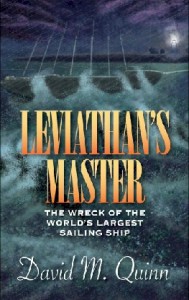 Leviathan’s Master: The Wreck of the World’s Largest Sailing Ship
Leviathan’s Master: The Wreck of the World’s Largest Sailing Ship
David M. Quinn
Review by Carol Buchanan
The leviathan of this short novel is the Thomas W. Lawson, a 7-masted schooner and the largest sailing ship ever built, which went down in a hurricane off Britain’s Scilly Isles on December 13, 1907. Her captain, or master, George W. Dow, and one other crewman survived the wreck. In Leviathan’s Master, David Quinn tells the story in first person from Dow’s perspective as he recuperates from his injuries.
Dow’s voice is clear and engaging, and Dow is a likable character, but Quinn does not appear to have made up his mind whether he is writing a fictionalized biography of Leviathan’s master or telling the story of the shipwreck.
And therein lies the novel’s central problem. Quinn attempts to do both. In my opinion, he succeeds better with the autobiography. When Dow reflects on his own life, I was sympathetic, but when he narrates his recollection of the shipwreck to a London reporter, I was not caught up in it. I should have been, because it was a harrowing experience for Dow. It could have been harrowing for the reader, but by using the device of the interview, the author kept me at a distance from the suffering on board as the ship broke up. For example, Dow says,
“Our voyage was forecasted to take fifteen days or so. It took us twenty-four. I think that second blow [storm] lasted about four days. As I recall, it began on December 1st or 2nd. Before it blew itself out, we were running with bare poles – all but six sails in tatters and those left were well furled. The winds blew us forward at such a rate. I would judge our speed at twelve knots or so – without canvas! Seamen took turns at the wheel for two-hour shifts – such was the mental effort required. They fought valiantly to keep the Lawson before the wind. Our days were like wakeful nightmares. Our nights were nearly sleepless. The sounds that ‘tin can’ made were unlike any I’d ever heard in almost fifty years at sea, in good weather or foul.”
The reporter, Francis Dagenham, does not come into the story until the beginning of chapter 4, so the reader must wait until then to read the narrative of the wreck. For all that time, I thought the book was mistakenly titled and the story was about Dow’s recovery.
Throughout the book, Dow’s injuries and his guilt torment him. As master of the ship, in retrospect he made a bad decision. He tells Dagenham how he came to make the disastrous choice to ride out the storm instead of fleeing before it.
The pilot, a local man, came on board to guide the ship to safety. When, Dow says, he asked him what he thought of their current position, he said:
“’I suggest that you make way tonight, as you are nearly surrounded by rocks and ledges. The tide now ebbs away to the west.’
“With the gravest expression I could muster, I told him, ‘Out of the question. My crew and ship are incapable of such a maneuver. The Lawson wears poorly in the best of conditions. Without adequate sails, without open waters, without a more experienced crew – tacking’ [turning around] ‘would be impossible. Our anchors, five tons each, are well set. Surely a tug will arrive by morning!’
“’I mean no disrespect, Captain,’” he said. ‘But your anchors will not hold against these seas.’”
As Dow learned before sunrise, the pilot was right.
Quinn uses an interesting combination of present and past tenses that I haven’t seen in many novels, but he makes it work. Dow’s convalescence and his troubling guilt is written in first person present, but events of his life that occur prior to his recovery, including the wreck, are told in first person past tense. The author handles the tense changes well. At no time was I confused about when the action took place.
In addition, Quinn’s style fits the formal presentations of the era, but used in a present day story, it would sound stilted. For example, Dow tells Dagenham:
“I was about forty or fifty feet above the deck when the ship hit. She rolled progressively over onto her starboard beam. The sound of steel grinding against granite was eerie, like the trumpeting of a charging elephant, I imagine. The ripping hull gave out metallic reports, as steel plates parted from underlying skeletal beams. No. 7 mast, seventeen tons of once impressive solidity, now wavered, snapping the three tons of wire rigging that once held it erect.”
By specifying the weights (“seventeen tons” and “three tons”), the author makes the story sound like a research report. These intrusive details help to keep the reader from feeling the terror of men whose ship screams as the storm tears it apart.
For all its problems, though, Leviathan’s Master is an engaging story of the Captain’s internal struggles, and he emerges as a likable, but tormented, man who made a decision that cost the lives of all but two, including the pilot.
Get an Editorial Review | Get Amazon Sales & Reviews | Get Edited | Publish Your Book | Enter the SPR Book Awards | Other Marketing Services






















Leave A Comment